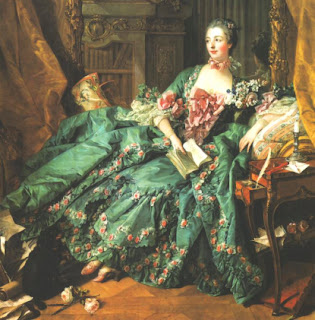Baroque and Rococo
Baroque and
Rococo eras existed from 1650-1800s.
The rise of
King Louis XIV, in the 16th century marked the beginning of a new
fashion era. The Baroque period came into existence and with that the
definition of fashion changed. This was the time when the influence of art,
culture, and fashion shifted from Versailles to Paris, and French fashion was
adopted as world fashion.
The Baroque
period was marked in the fashion history for its sheer indulgence,
extravagance, and luxury. Unlike the other periods in Europe, fashion was no
longer confined to the upper classes; baroque period presented the lower
classes with the freedom of keeping up with the new styles and fashion trends.
This was also the time where fashion designers were on a rise, being in demand
by the higher as well as the middle classes.
This era was
distinguished by its rich use of brilliant colours and fabrics. Natural
silhouettes became popular with the use of grandeur and intricate
embellishments like ribbons, pearls, lace, and gold embroideries. The upper
class indulged in a variety of expensive fabrics like silks, velvets, and brocades
of the most beautiful colours and patterns. In contrast to this the poor
sections of the society could only afford to wear wool.
Women’s
clothing and silhouettes also transformed into much simpler and comfortable
forms than the previous eras. From the tight corsets, non-breathable garments
and unmanageable skirts the silhouettes changed to more flowing and natural
with layered skirts. The plunging necklines with lace, known as the décolletage
were also a popular trend during the time.
The
extravagance did not end with the clothing. Hair and makeup trends became an
important element to indulge in. with the new and fancy hairstyles, and the
rouges for lips and cheeks, hair and makeup also became a part of the daily
extravagance.
Similar to
the women’s fashion, men’s fashion also went through major changes during the
baroque period. The clothing became more comfortable and extravagant. Men’s
clothing changed into knee length, high waist breeches and ruffled lace collars
and cuffs. Square toed shoes and high heeled boots became popular, along with
extravagant wigs and curly hairstyles.
Rococo Era
came into existence at the beginning of the 18th century. This was
the time of a significant cultural shift that occurred in France; art, culture,
and fashion gained new importance. The new fashion trends did not only affect
the royals and the aristocrats but also the middle and the lower classes. Louis
XVs mistress Madame Pompadour was the main figure behind the introduction of
the Rococo fashion. It was her love for light, floral patterns and pastel
colours that started the new trends and came to be known as Rococo fashion.
This was the
time when fashion designers gained more important and influenced the people of
all social classes with the latest styles and trends. Fashion magazines were
the new go-to thing to keep up with the latest fashion. The most important
iconic fashion figures during the era were Madame Pompadour, Marie Antoinette,
and her dressmaker Rose Bertin.
With the
Rococo Era, women’s clothing and fashion took a new turn. New silhouettes were
developing and the fashions were changing. The natural silhouettes were
transformed into elaborate and full skirts. Panniers and wide hoops came into
trend, they were worn under the skirts to make it a full skirt with the cinched
up waist provided by the tight and constructing corsets. Gowns with tight
bodices and plunging necklines also became popular among women. Women’s heels
became fancier with much more slimmer and daintier heels. Powdered wigs and towering hairstyles adorned with
flowers, ribbons and feathers became part of the daily outfit.
Men’s
fashion also incorporated minor changes during the Rococo Era. The basic coat,
waistcoat, and breeches were transformed into more extravagant versions. The
coats and waistcoats became flowing and more decorative with lavish embroidery
and embellishments. Knee length breeches with white stockings and heeled boots
were popular among men.












No comments:
Post a Comment